Although we can't complain about the winter we had this year mother nature is playing tricks on us again. Signs of spring and warm weather and now snow tomorrow?? What gives?
While walking through the garden you can see signs of spring trying to emerge. The fish in the pond will venture towards the water surface when the sun is beating down on them but when the air changes back to cold they hid. Its been an unusually warm March and April than in the past.
Mother Nature has a way of tricking even the most experienced water gardener. We finally have a week of warm temperatures, and things are coming alive in our ponds. After months of rain, sleet, snow and ice we are all ecstatic. Armed with our pond gloves, waders and nets, we set out to begin cleaning our ponds. Throwing in some MicrobeLift Spring & Summer, clean our filters and hope algae doesn't start to grow until we can get some plants in. We check temperatures and think it is time to add some plants. Seems safe, after all the temperatures are rising. Place our orders, plants arrive and all seems well. Then out of nowhere (actually Canada), comes a cold front with freezing nighttime temperatures. We frantically remove our floating plants, new bog plants and place them in the garage or on the covered porch for the next couple of days. Then, temperatures rise again and out the plants go again. We try our best to ship the plants when the time is right for planting in your planting zone. Unfortunately, we can not control Mother Nature and her unpredictable ways. Just, remember when receiving new plants in the Spring to keep a watchful eye on the temperatures, in case Mother Nature tries to play a trick on you!
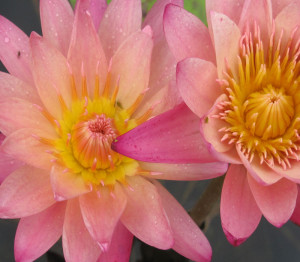 Its officially fall now and we need to begin preparing our pond for the winter and hopefully a cleaner pond for spring. I've listed a few maintenance tips to guide you through preparing your pond for the winter. I still have a few flowers appearing in my pond but I think they are almost through blooming for the season 🙁
Its officially fall now and we need to begin preparing our pond for the winter and hopefully a cleaner pond for spring. I've listed a few maintenance tips to guide you through preparing your pond for the winter. I still have a few flowers appearing in my pond but I think they are almost through blooming for the season 🙁
FALL/WINTER POND MAINTENANCE TIPS
1. Before winter arrives, you will want to make sure your pond and filtering system are clean to ensure good water quality throughout the winter months. With the arrival of fall it is wise to do a partial water change to remove any built up contaminants to improve water quality. Partial water changes need to be made before water temperatures fall below 60 degrees to minimize fish stress. Adding pond salt at this time will improve the slime coating of fish, to help them ward off disease and parasites.
2. Before the leaves begin to fall, cover your pond with one of ourpond nets. The goal is to try and keep the pond as clean as possible for the winter months. Leaves will sink to the bottom of the pond and rot, causing excess carbon dioxide and hydrogen sulfide. After the first frost, take out any floating plants, as these will begin to decay. Trim back hardy lilies and bog plants and place below the freeze line.
3. Switch to Microbe-Lift Autumn/Winter Prep. This will help break down organic material in the pond before winter sets in. Microbe-Lift Autumn/Winter Prep helps accelerate the decomposition of leaves, scum, sediment and other organic matter during the fall and throughout the winter months. Also, Microbe-Lift Autumn/Winter Prep helps to maintain a healthy immune system for your fish during the winter months. Microbe-Lift Autumn/Winter Prep will help jump-start your pond to a healthier environment in the spring.
4.Reduce your fish feeding as the water temperatures drop below 60 degrees. Start feeding your fish a couple of times a week. We recommend switching to a wheat germ based fish food formulated for fall and spring feeding. When water temperatures drop below 60 degrees, the metabolism of your fish slow down. Both Tetra-Pond Spring/Fall and Microbe-Lift Cold Weather fish food are highly digestible cool weather diets that are made with less protein, but contain wheat germ, which is easily digested. They also contain higher levels of fat, which help your fish survive their winter hibernation. When water temperatures reach 50 degrees, stop feeding your fish completely. Feeding at water temperatures below 50 degrees can possibly kill your fish. A pond thermometeris a must have. This will help you in determining when to stop feeding your fish and will also help to know when to begin feeding your fish in the spring. Its also a good idea to know your water temperature for those adding tropical pond plants to your pond in the spring.
5.Adding Microbe-Lift Barley Straw Extract will help control string algae throughout the fall and winter months. Barley Straw Extract is an effective and eco-friendly way to reduce algae. Unlike algaecides, which are ineffective in water temperatures below 50 degrees, Microbe-Lift Barley Straw Extract will continue to control algae throughout the winter months.
6.Before freezing temperatures begin, install a pond de-icer. Ponds covered with ice do not allow toxic gases to escape causing fish loss. A pond de-icer will keep a section of your pond open to allow oxygen and gas exchange.
7.During the winter removing snow from the surface of the pond will help submerged plants and microscopic aquatic plants to continue to produce oxygen as long as light penetrates through the ice. Insufficient light, along with the decomposition of plant and leaf debris may result in insufficient oxygen for the fish, causing them to suffocate. Removing the snow from a portion of your surface area will reduce the likelihood of this occurring.
Remember to add a tray of sand in your pond for the frogs to have a place to winter over.
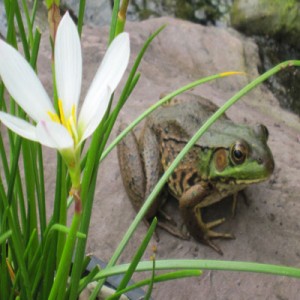 This frog is getting brave.....I can get close to him and it doesn't seem to matter. That is if I talk before I get to him so it doesn't frighten him. He likes to hid behind my Rain Lily. Maybe he just likes his picture taken hehe. I sure do alot of that. Now there are other frogs camping out in my pond also, but mostly small ones...the tadpoles from early spring. They aren't as friendly as MR. BIG FROG. Whenever I try and get close to snap a picture they jump right into the pond. This is the closest shot I could get....took one more step and he was gone.
This frog is getting brave.....I can get close to him and it doesn't seem to matter. That is if I talk before I get to him so it doesn't frighten him. He likes to hid behind my Rain Lily. Maybe he just likes his picture taken hehe. I sure do alot of that. Now there are other frogs camping out in my pond also, but mostly small ones...the tadpoles from early spring. They aren't as friendly as MR. BIG FROG. Whenever I try and get close to snap a picture they jump right into the pond. This is the closest shot I could get....took one more step and he was gone.
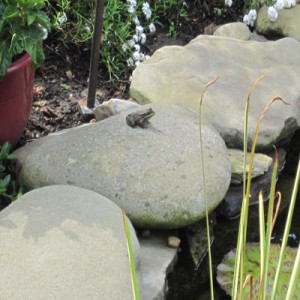 PLOP right into the pond. I think I saw Mr. Big Frog just shake his head....
PLOP right into the pond. I think I saw Mr. Big Frog just shake his head....
Since we're starting to get our ponds ready for the winter now is also a good time to create a place for those frogs we've watch grow from tadpoles this summer. You may want to put a tray, such as a kitty litter tray in the bottom of your pond with sand in it. This will give the frogs a place to bury themselves over the winter. Sometimes if you have a filter box or skimmer they may camp out there so be sure that your pump intake is protected so they don't get stuck in it. I've opened my skimmer early spring and had them jump out. If you have muck in the bottom of your pond they will also bury themselves in there. Its nature so frogs will find a way to survive over the winter.
Well the holidays are over, the tree is down and all the holiday christmas decorations are put away. I could probably leave my christmas tree up for months as I always miss it once its put away. Its hard to imagine the room is exactly like it was a month ago because it looks so bare now. With that behind I start thinking that in just a few months it will be spring again. My how time flies. The plants are all beginning to grow nicely in the greenhouses and within a couple months will be ready to plant.
No sooner said then the snow began...let's hope February is a quick month and we can all get started on our spring projects and planning our gardens. Actually January is a good month to start ordering some plants for your gardens, at least I'm getting alot of plant magazines in the mail. So its getting me in the mood.
There are iris of almost any color one would want.....of course I want to plant them all around the pond. Although they only bloom once during the season I anxiously await their blooms. The Colorific is exactly like its name...blending of colors and quite unique. This plant only had about three flowers on it this year since it was just planted but next year will have more.
Then there is the Clyde Redmond which blooms a little later in the season. Its nice to have different iris blooming at different times of the season. The Wedgwood blue color of this iris adds alot to the pond.
Other than dividing the iris in the early spring they require little care and the rewards of color in your pond are worth it.
 Those annoying predators.....the one we dislike the most when we have fish swimming about. Some of our customers have had their ponds depleted of fish because of the blue heron! They are beautiful birds but please stay away from our ponds. You'd think they'd go for the larger ponds with more fish.
Those annoying predators.....the one we dislike the most when we have fish swimming about. Some of our customers have had their ponds depleted of fish because of the blue heron! They are beautiful birds but please stay away from our ponds. You'd think they'd go for the larger ponds with more fish.
Blue Herons are territorial. If they see another bird at your pond, they will simply move on to another pond for their next meal. Our life-like statue is decorative and will help keep other herons away. Just make sure you move it periodically, or the real birds get wise to the fact that it is fake!
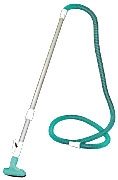 A Dragonfly Aquatics Best Seller! The Muck Vac does not cause turbulence in the pond because all the muck, dirt and fish waste are vacuumed out of the pond into your yard or garden. If you place the out-take hose in a flower bed, it is great fertilizer for your surrounding flower beds around the pond. The Muck Vac requires 50 PSI garden hose pressure to work effectively. It comes with a power head, a telescoping pole, a waste hose and a vacuum head brush. The Muck Vac sure makes Spring cleaning your pond simple!
A Dragonfly Aquatics Best Seller! The Muck Vac does not cause turbulence in the pond because all the muck, dirt and fish waste are vacuumed out of the pond into your yard or garden. If you place the out-take hose in a flower bed, it is great fertilizer for your surrounding flower beds around the pond. The Muck Vac requires 50 PSI garden hose pressure to work effectively. It comes with a power head, a telescoping pole, a waste hose and a vacuum head brush. The Muck Vac sure makes Spring cleaning your pond simple!
Check out Pond Vac here.
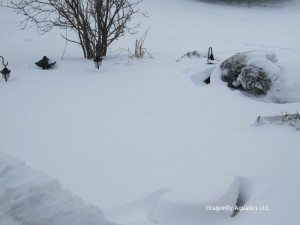 Where is my pond and the fish? They are in complete darkness probably wondering what happened overnight since yesterday even some of the ice had melted away and I could see the fish.
Where is my pond and the fish? They are in complete darkness probably wondering what happened overnight since yesterday even some of the ice had melted away and I could see the fish.
We just were blessed with 8 inches of snow overnight but who can complain when the East got so much more snow than Ohio. You have to admit it is pretty even if I'm anxiously awaiting spring as I'm sure most of you are too.
I thought I'd do a series on the different cattails since there are several and each is alittle different. The cattail is a bold vertical accent for any pond or water garden. We carry the Common Cattail, Dwarf Cattail, Graceful Cattail, Variegated Cattail and Zebratails Cattail.
Today we'll talk about the Common Cattail also known as the Typha latifolia, which is the most popular of the cattails. This cattail we often see growing in wetlands and ditches. It is used often as water filtration and will add dimension to any water garden landscape. For those creating a water garden using a natural filtration system rather than a filter system this would be a good plant for that purpose.
Its also a good pond plant to add to encourge Dragonflies to your pond since they like to perch on them, especially the juveniles since it gives them a place to crawl up when they emerge from the water. To attract the dragonflies you would want to plant them away from fast moving water or waterfalls. They prefer calming waters.
It grows in sun to part shade and does well in moist soil or water up to 12 inches deep and will reach close to 7 feet tall. It is considered to be a hardy bog pond plant and will survive in Zones 3-11.
Common Cattail
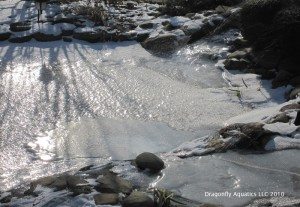 I almost can visualize the thawing of the ice.....even if its only 12 degrees this morning. Today a heat wave, yesterday morning it was only 3 degrees. But its February now so we can all start thinking about spring. When the pond is frozen I always wonder what those little fish are doing under there. There have been a few days this winter when the ice started to melt and the fish were near the top checking things out. It wasn't long and they disappeared again probably thinking its just too cold yet to go up there.
I almost can visualize the thawing of the ice.....even if its only 12 degrees this morning. Today a heat wave, yesterday morning it was only 3 degrees. But its February now so we can all start thinking about spring. When the pond is frozen I always wonder what those little fish are doing under there. There have been a few days this winter when the ice started to melt and the fish were near the top checking things out. It wasn't long and they disappeared again probably thinking its just too cold yet to go up there.
I start getting anxious in February for spring to arrive and like many of you probably start thinking about what I want to plant this year. We've been pretty lucky so far this winter in Ohio. It seems the snow keeps wanting to go south......lucky for us but not so lucky for those in the south.
We have alot to share this year and are really excited about our pond plants so let's all start thinking SPRING and visualizing those water lilies floating on our ponds and the fish waiting at the edge of the pond for their treats. It won't be long now.
 Some of you further north of us, are already getting some chilly nights. The leaves on your trees are already showing the colors of fall. Here, in Ohio things are just beginning to change. In the past week, I've noticed a few splotches of color. Before the leaves begin to fall, cover your pond with one of our pond covers. The goal is to try and keep the pond as clean as possible for the winter months. Leaves will sink to the bottom of the pond and rot, causing excess carbon dioxide and hydrogen sulfide. After the first frost, take out any floating plants, as these will begin to decay. Trim back hardy lilies and place below the freeze line. Trim foliage back on your hardy bog plants. Not all bog plants need to be submerged, some will be fine where they are. Check out each plants individual needs to ensure they re-appear in the spring for you.
Some of you further north of us, are already getting some chilly nights. The leaves on your trees are already showing the colors of fall. Here, in Ohio things are just beginning to change. In the past week, I've noticed a few splotches of color. Before the leaves begin to fall, cover your pond with one of our pond covers. The goal is to try and keep the pond as clean as possible for the winter months. Leaves will sink to the bottom of the pond and rot, causing excess carbon dioxide and hydrogen sulfide. After the first frost, take out any floating plants, as these will begin to decay. Trim back hardy lilies and place below the freeze line. Trim foliage back on your hardy bog plants. Not all bog plants need to be submerged, some will be fine where they are. Check out each plants individual needs to ensure they re-appear in the spring for you.
Get your pond cover, de-icers here.